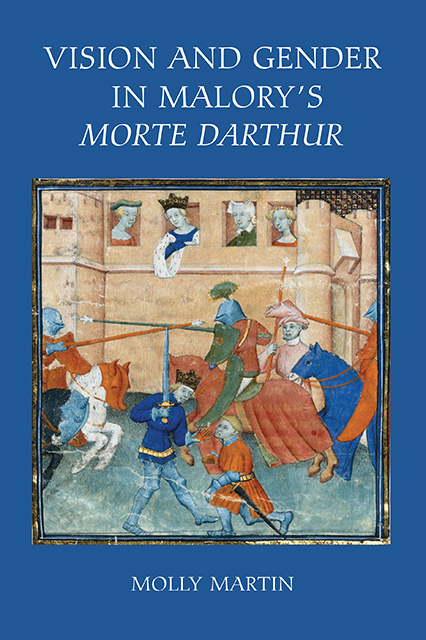Book contents
- Frontmatter
- Contents
- Acknowledgments
- Editorial Note
- Introduction: Masculinity and Vision in the Morte Darthur
- 1 “Beholdyng” Gareth: The Spectacle of Romance Masculinity
- 2 Gazing at the Queen: Trystram and Launcelot
- 3 Seeing Unseen: Palomydes and the Failure of Masculine Display
- 4 Romancing Religion: Competing Modes of Vision on the Grail Quest
- 5 The Female Gaze: Constructing Masculinity with and without Men
- Conclusion: Malory’s Arthurian Visions of Masculinity
- Bibliography
- Index
- Miscellaneous Endmatter
1 - “Beholdyng” Gareth: The Spectacle of Romance Masculinity
Published online by Cambridge University Press: 01 March 2023
- Frontmatter
- Contents
- Acknowledgments
- Editorial Note
- Introduction: Masculinity and Vision in the Morte Darthur
- 1 “Beholdyng” Gareth: The Spectacle of Romance Masculinity
- 2 Gazing at the Queen: Trystram and Launcelot
- 3 Seeing Unseen: Palomydes and the Failure of Masculine Display
- 4 Romancing Religion: Competing Modes of Vision on the Grail Quest
- 5 The Female Gaze: Constructing Masculinity with and without Men
- Conclusion: Malory’s Arthurian Visions of Masculinity
- Bibliography
- Index
- Miscellaneous Endmatter
Summary
Throughout the Morte, Malory regularly addresses intromissive sightlines, the collapsed gaze, and their fissuring effects on masculinity by creating a spectacle of manly prowess. Within the smaller segments of the Morte, and particularly in the cases of visually motivated desire, the genre in Malory's hands “corrects” its construction of masculinity, using the same model of intromissive vision, but replacing the image of the beloved women as the focal point with that of the masculine knight. The subversive inward visual patterns, which temporarily captivate the male viewer, are downplayed by quick and action-centric narrative and overshadowed by ensuing scenes of masculinity: Gareth's gaze on Lyones at first renders him unable to act, but quickly produces battle triumph. The very visible performance of knighthood repairs or reaffirms fractured male gender identity; the capital of masculinity – deeds performed, battles won, knights vanquished and made subservient – is explicitly visual and can be judged both quantitatively and qualitatively. “The Tale of Sir Gareth of Orkney That Was Called Bewmaynes” exemplifies the author's methodological process of enhancing masculine identity within the confines of the romance genre, namely via the repeated presentation of battle scenes and tournaments. Gareth and his gender identity suffer upon seeing Lyones, but these gazes often result in a masculine display. The manner in which Malory navigates the complex web of gazes and its gender implications in the “Gareth” restores gender order and simultaneously attests to the romance genre's validity as a vehicle for the promulgation of masculinity. Both because it lacks a specific and known source and because it is a rather self-contained episode, the “Gareth” provides an ideal entry to the discussion of vision and masculinities in Malory's text. The completeness of the tale allows a microcosmic look at the functioning of vision and visibility that pervades the larger work. Both the tale and its titular hero become paradigmatic models – at least until Gareth opts for marriage – of the production (and reproduction) of masculinity on the visual stage of Malory's text.
Generically, the “Gareth” in many ways represents the most ideal of chivalric romances in the Morte. This ideal romance tale exhibits a confluence of two key aspects of the genre: the intertwined narratives of love and masculine performance.
- Type
- Chapter
- Information
- Vision and Gender in Malory's Morte Darthur , pp. 25 - 48Publisher: Boydell & BrewerPrint publication year: 2010



